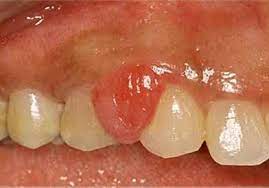The natural and rapid changes in the functions of a pregnant woman, such as weight gain, increased metabolism, and increased blood volume, often lead to anemia, gestational diabetes, hypertension, thyroid hyperfunction, fluid retention, and lower limb edema, as well as hypotension in the supine position.
In women already affected by hormonal and immunological disorders, these changes can have even more pronounced effects on the body’s physiology.
In the oral cavity, the most common problems are gum diseases, gingivitis, periodontitis, pregnancy tumors (pyogenic granuloma), bleeding due to hypertension, erosion of hard dental tissues as a result of frequent vomiting, and edematous mucosa. The typical symptoms of gingivitis (including pregnancy gingivitis) are:
- Red, painful, hyperplastic, and inflamed gums
- Frequent bleeding, either spontaneous or during brushing
- Bad breath and altered taste

The presence of periodontal disease in pregnant women has been linked to an increased risk of preterm birth. According to the American Academy of Periodontology, pregnant women with periodontal disease are up to seven times more likely to give birth prematurely, with the newborn having a low birth weight. This may be due to prostaglandins produced by the body to combat gum inflammation, which are considered potential factors in hastening labor.
Knowing that pregnancy comes with numerous oral health implications, the supervising gynecologist should refer women planning to conceive and those already pregnant to their dentist to avoid invasive procedures during sensitive periods of pregnancy (first trimester and often 37-41 weeks). If necessary, the dentist can perform any needed treatment in the least invasive way.
Regarding radiographs, during pregnancy, examinations or treatments involving ionizing radiation are generally avoided. However, there are instances where pregnant women are exposed to radiation for medical reasons, either voluntarily or involuntarily. The risk to the pregnant woman and the fetus from a local dental X-ray (with concentrated radiation on the head) for diagnostic purposes is considered negligible by the Hellenic Atomic Energy Commission. Once informed of the pregnancy, appropriate measures (such as the use of a lead apron) are taken to protect the fetus.
The primary concern of dentists should be to relieve pain and address inflammation so that, if possible, treatment can be postponed until after childbirth. In urgent situations where medication and local anesthetics must be administered, always in consultation with the gynecologist, the usual painkillers and antibiotics can be given, and local anesthesia can be administered using lidocaine + 2% epinephrine, mepivacaine 3%, with careful attention to the total amount of drug administered. Pain relief can also be provided with acetaminophen or ibuprofen, and antibiotics such as penicillin, amoxicillin, cephalosporins, clindamycin can be prescribed. Chlorhexidine mouthwashes (antimicrobial agent) and fluoride treatments are also considered safe.
General Characteristics of Each Trimester and Instructions for Treating Physicians and Pregnant Patients
First Trimester (conception to 14th week)
Rapid cell division and organogenesis occur during this period, making it a time with higher potential complications due to stress. About 50-70% of spontaneous miscarriages happen during this time.
Instructions
- Educate the patient about changes in the oral cavity due to pregnancy.
- Emphasize maintaining good oral hygiene and provide instructions to reduce dental plaque and caries.
- Dental procedures should be limited to emergency treatments or simple cleanings.
- Avoid radiographs unless absolutely necessary in emergencies, and always use protective measures.
Second Trimester (14th to 28th week)
Organogenesis is complete, and the risk to the fetus is now very low. Some more invasive dental procedures can be safely performed.
Instructions
- Provide instructions for maintaining good oral hygiene to reduce dental plaque and caries.
- If necessary, perform scaling with ultrasonic or hand tools.
- Treat active inflammations and caries.
- Perform aesthetic dental treatments.
- Avoid radiographs unless absolutely necessary in emergencies, and always use protective measures.
Third Trimester (29th week to birth)
Although there is no risk during this trimester, the expectant mother may feel increased discomfort, stress, and anxiety. Dental procedures should be brief and performed in a position that is more comfortable for the patient (avoiding the supine position). From the middle to the end of the third trimester, avoid treatments that can be postponed until after birth.
Instructions
- Provide instructions for maintaining good oral hygiene to reduce dental plaque and caries.
- If necessary, perform scaling with ultrasonic or hand tools.
- Avoid aesthetic interventions from the middle to the end of the trimester.
- Avoid dental radiographs unless absolutely necessary in emergencies, and always use protective measures.
In summary, during pregnancy, the patient is not only the mother but also the fetus. All treatments should be performed in consultation with and with the consent of the gynecologist. It is clearly better to avoid medications and treatments that could endanger the fetus in women of reproductive age until pregnancy is confirmed or ruled out. Dentists should avoid surgical procedures unless they are deemed urgent. The goal of all treatments should be to address acute trauma, pain, inflammation, or pathological conditions that cannot be postponed and to maintain the good health of both mother and fetus.
Suggested Reading:
Theologi-Lygidakis Nadia, Assistant Professor of Oral and Maxillofacial Surgery, School of Dentistry, University of Athens: “The Patient with a Compromised Medical History in the Dental Office.”
Kurien S, Kattimani VS, Sriram RR et al.: “Management of pregnant patient in Dentistry.” J Int Oral Health, 5(1): 88-97, 2013.
Livingston HM, Dellinger TM, Holder R. “Considerations in the management of the pregnant patient.” Spec Care Dentist. 1998 Sep-Oct;18(5):183-8. doi: 10.1111/j.1754-4505.1998.tb01737.x. PMID: 10219182.
Hellenic Atomic Energy Commission (https://eeae.gr)
American Dental Association (https://www.ada.org/en/about-the-ada)

